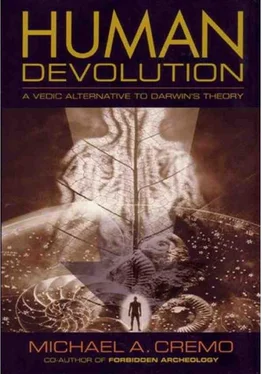Michael Cremo - Human Devolution - A Vedic Alternative To Darwin's Theory
Здесь есть возможность читать онлайн «Michael Cremo - Human Devolution - A Vedic Alternative To Darwin's Theory» весь текст электронной книги совершенно бесплатно (целиком полную версию без сокращений). В некоторых случаях можно слушать аудио, скачать через торрент в формате fb2 и присутствует краткое содержание. Год выпуска: 2003, ISBN: 2003, Издательство: Torchlight Publishing, Жанр: Старинная литература, на английском языке. Описание произведения, (предисловие) а так же отзывы посетителей доступны на портале библиотеки ЛибКат.
- Название:Human Devolution: A Vedic Alternative To Darwin's Theory
- Автор:
- Издательство:Torchlight Publishing
- Жанр:
- Год:2003
- ISBN:9780892133345
- Рейтинг книги:4 / 5. Голосов: 1
-
Избранное:Добавить в избранное
- Отзывы:
-
Ваша оценка:
- 80
- 1
- 2
- 3
- 4
- 5
Human Devolution: A Vedic Alternative To Darwin's Theory: краткое содержание, описание и аннотация
Предлагаем к чтению аннотацию, описание, краткое содержание или предисловие (зависит от того, что написал сам автор книги «Human Devolution: A Vedic Alternative To Darwin's Theory»). Если вы не нашли необходимую информацию о книге — напишите в комментариях, мы постараемся отыскать её.
Human Devolution: A Vedic Alternative To Darwin's Theory — читать онлайн бесплатно полную книгу (весь текст) целиком
Ниже представлен текст книги, разбитый по страницам. Система сохранения места последней прочитанной страницы, позволяет с удобством читать онлайн бесплатно книгу «Human Devolution: A Vedic Alternative To Darwin's Theory», без необходимости каждый раз заново искать на чём Вы остановились. Поставьте закладку, и сможете в любой момент перейти на страницу, на которой закончили чтение.
Интервал:
Закладка:
Some versions of the anthropic principle hold that human observers should not only expect to find themselves in a universe of a certain age and size, but also in a universe where the values of physical constants and ratios of natural forces are finely tuned to allow the very formation of that universe and the human life in it. It is this initial fine tuning which is of most interest to me. My discussion of the fine tuning problem will be based primarily on two main sources: the book Just Six numbers by Sir Martin Rees, the astronomer royal of Great Britain, and the book the Cosmological anthropic Principle by astronomer John D. Barrow and physicist Frank J. Tipler.
Fine tuning
Physicist John Wheeler, known for his many worlds interpretation of quantum mechanics, wrote (Barrow and Tipler 1986, p. vii), “It is not only that man is adapted to the universe. The universe is adapted to man. Imagine a universe in which one or another of the fundamental . . . constants of physics is altered by a few percent one way or the other. Man could never come into being in such a universe. That is the central point of the anthropic principle. According to this principle, a life-giving factor lies at the center of the whole machinery and design of the world.” Let us now look at the numerical values associated with some of these fundamental constants and ratios of natural forces, and see exactly what would happen if each of them were changed only slightly.
The large number N and Gravity
According to modern cosmology, the size of the universe and the sizes of the objects and living things in it are related to the ratio between the force of electromagnetism and the force of gravity (Rees 2000, pp.
27–31). Atoms are composed of subatomic particles with different electric charges. Among these subatomic particles are electrons and protons. Electrons have negative charge and protons have positive charge. The electromagnetic attraction between the positive and negative charges of electrons and protons is one of the factors holding the atom together. The force of gravity also acts among the subatomic particles making up the atom. But the force of gravity is much weaker than the electromagnetic force. The ratio of gravity to electromagnetism is obtained by dividing the strength of the electromagnetic force by the strength of the gravitational force. The resulting number ( n ) is 1036, which means that the gravitational force is 1,000,000,000,000,000,000,000,000,000,000,000,000 times weaker than the electromagnetic force.
On the atomic scale, gravity does not have much of an effect. But on the larger scale, gravity does have a very noticeable effect, even though it is much weaker than electromagnetism. The positive and negative charges in atoms cancel each other out. This means that on the large scale we do not feel very much of an effect from electromagnetism (unless the electromagnetic charges in an object are aligned, as in a magnet or an electric current). But gravity is always positive. The more mass present in an object, the greater its gravity. So when there are large aggregates of atoms their masses add up, and the force of gravity increases proportionately. The combined force of the gravity in the mass of all the atoms in the earth holds us down on the surface of the earth. In fact, the force of gravity determines how big living things can be on a particular planet. If the force of gravity were slightly stronger, the maximum size of living things would decrease. Let us imagine that n was 1030 instead of 1036. Then gravity would be “only” 1,000,000,000,000,000,000,000,000,000,000 times weaker than electromagnetism. As a result of this small change (just a few zeroes), the force of gravity on earth would be so heavy, that no creatures larger than insects would be able to survive the pressure. And even these little insect sized creatures would have to have massive legs. And that’s not all.
Everything in the universe would be much smaller. For example, it would take a billion times fewer atoms to make a star.According to current thinking, stars form when the gravitational force of the atoms in hydrogen and helium gas clouds causes the gas to condense.As the gas condenses it becomes heated, and when the gas becomes dense enough and hot enough, it triggers fusion reactions. The heat of the fusion reactions pushes the star’s material outwards, but the force of gravity holds it in. The balance between the outward expansion and inward contraction causes stars to assume a particular size. The star has to be big enough to have enough gas molecules to collapse into a core with enough pressure to start the atomic fusion process. And the star has to retain enough mass to keep the heat generated by that fusion process from forcing all the materials of the star out into empty space. In general, stars normally have to be quite big. If, however, the force of gravity were greater, it would take fewer atoms to start the fusion process and fewer atoms to overcome the outward expansion. If n were 1030 instead of 1036, it would take a billion times fewer atoms to overcome the force of outward expansion. This means that stars would be much smaller. They would also burn their nuclear fuel much more quickly. A fire with a little bit of fuel is normally going to go out more quickly than a fire with large amount of fuel. According to Rees (2000, p. 31), the average lifetime of a star would be ten thousand years rather than ten billion years. That would have quite a negative impact on the possibility of biological evolution of the kind scientists now imagine. Galaxies would also be much smaller, and would be more densely packed with stars. The dense packing of stars would interfere with the orbits of planets circling those stars. And we have to remember that the presence of life depends on stable orbits for planets. If our own planet’s orbit were not stable the extremes of temperature on earth would be too great for life as we know it to survive. Why does N have the precise value it does? Rees (2000, p. 31) says, “We have no theory that tells us the value of N . All we know is that nothing as complex as humankind could have emerged if N were much less than 1,000,000,000,000,000,000,000,000,000,000,000,000.”
The Binding energy ε
The binding energy ε is another cosmic number that greatly influences the characteristics of our universe (Rees 2000, pp. 43–49). It determines how atoms are formed, and how nuclear reactions take place. Of course, this is also very important for the existence of life forms.
Atoms of different elements have different binding energies. For us, the most important is the binding energy of helium. According to today’s astrophysicists, the first generation of stars converts hydrogen into helium by fusion. The nucleus of a hydrogen atom contains one proton. The nucleus of deuterium, an isotope of hydrogen, contains one proton and one neutron. When two deuterium atoms fuse, they form an atom of helium, with two protons and two neutrons. The nucleus of the helium atom has a mass equivalent to .993 (99.3 percent) of the mass of the two protons and two neutrons it contains. In the process of fusion, .007 (0.7 percent) of the mass is converted into energy, mostly heat. This number .007 is ε, the binding energy of atomic nuclei. It is related to the strong nuclear force, which keeps the protons in the atom together. Rees (2000, p. 48) says, “The amount of energy released when simple atoms undergo nuclear fusion depends on the strength of the force that ‘glues’ together the ingredients in an atomic nucleus.” The greater the binding energy, the greater the strength of the strong nuclear force. The protons in the nucleus have positive charge, and normally positive charges will repel each other, thus blowing the atom apart. But the strong nuclear force is just strong enough to overcome this repulsion, and holds the protons together in the nucleus. We do not feel this force, because it operates only within the nucleus of the atom.
Читать дальшеИнтервал:
Закладка:
Похожие книги на «Human Devolution: A Vedic Alternative To Darwin's Theory»
Представляем Вашему вниманию похожие книги на «Human Devolution: A Vedic Alternative To Darwin's Theory» списком для выбора. Мы отобрали схожую по названию и смыслу литературу в надежде предоставить читателям больше вариантов отыскать новые, интересные, ещё непрочитанные произведения.
Обсуждение, отзывы о книге «Human Devolution: A Vedic Alternative To Darwin's Theory» и просто собственные мнения читателей. Оставьте ваши комментарии, напишите, что Вы думаете о произведении, его смысле или главных героях. Укажите что конкретно понравилось, а что нет, и почему Вы так считаете.












